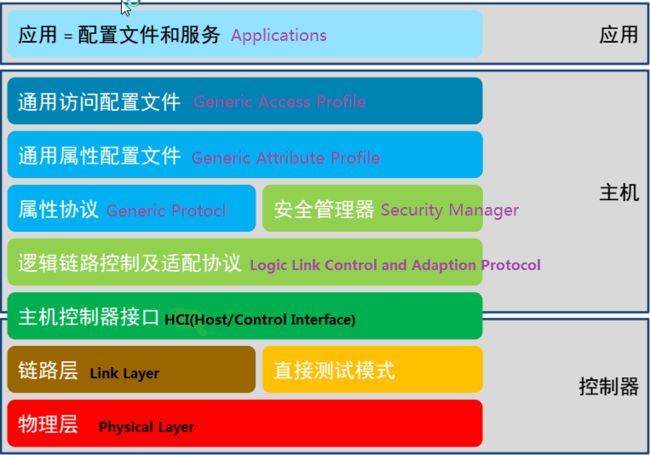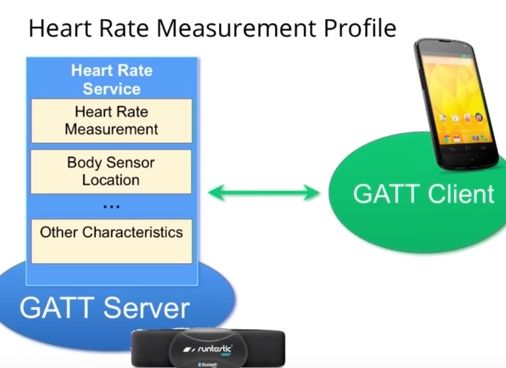低功耗蓝牙(BLE)官方文档翻译
翻译之间先看几张BLE Stack图:
BLE Stack:
BLE GATT stack:
低功耗蓝牙(Bluetooth Low Energy)
Android4.3(API 18)引入BLE低功耗蓝牙,并且提供了相应的API供应用程序搜索蓝牙设备,查询服务,读写特性.与经典蓝牙相比,BLE的显著特点是低功耗, 使得android应用可以和具有低功耗要求的蓝牙设备进行通讯,如传感器,心率检测器,健身设备等等.
关键术语和概念(Key Terms and Concerpt)
Generic Attribute Profile(GATT): 通用属性协议
GATT配置文件是一个通用的规范, 用于在BLE链路上发送和接收被称为”属性”的数据块.目前所有的BLE应用都是基于GATT.- 蓝牙SIG规定了许多低功耗设备的配置文件.配置文件就是设备如何在特定应用中运转的规格说明.注意一个设备可以实现多个配置文件,例如:一个设备可以包含心率监测器和电量检测器.
Attribute Protocol(ATT) 属性协议
GATT是建立在ATT协议的基础上的.ATT对在BLE设备上运行做了优化,为此他使用了尽可能少的字节,每个属性都通过一个唯一的统一标识符(UUID)来标识,每个String类型的UUID使用是128bit标准格式,属性通过ATT被格式化为characteristics 和servicesCharacteristic 特性
一个CXharacteristic包含一个单一变量和0-n个用来描述characteristic变量的descriptor,characteristic可以被认为是一个类型, 类似于类.Descriptor 描述
Descriptor用来描述characteristic变量的属性.例如,一个descriptor可以规定一个可读的描述,或者一个characteristic变量可接受的范围,或者一个characteristic变量特定的测量单位.Service 服务
service是characteristic的集合.例如,你可能有一个叫Heart rate minitord的service,他包含了很多characteristic,如 heart rate measurement等等.可在bluetooth.org找到一个目前支持基于AGTT的配置文件和服务列表
角色和责任(Roles & Responsiblity)
- 一下是android设备和BLE设备交互时的角色和责任
- 中央 vs 外设: 使用与BLE连接本身.中央设备扫描,寻找广播,外围设备发出广播
- GATT服务端 vs GATT客户端: 决定了两个设备在建立连接后如何交互
- 为了方便理解,想象你有一个用于活动跟踪BLE设备,手机支持中央角色,后动跟踪器支持外围活动(为了建立BLE连接你需要注意两件事,只支持外围设备的两方或者只支持中央设备的两方不能互相通讯.
- 当手机和运动跟踪器建立连接后,他们开始向另一方传输GATT数据.哪一方作为服务器取决于他们传输数据的种类.例如,如果运动跟踪器想向手机报告传感器数据,运动跟踪器就是服务器.如果运动跟踪器更新来自手机的数据,手机作为服务器.
BLE权限(BLE Permissions)
- 为了在应用中使用Bluetooth特性,必须要声明BLUETOOTH权限.你需要这个权限区执行任何蓝牙通讯,例如请求连接,接收连接,传输数据.
- 如果你想要App应用初始化设备搜索或者手动操作蓝牙设置,你必须声明BLUETOOTH_ADMIN权限.注意:如何要使用BLUETOOTH权限,比先声明BLUETOOTH权限.
- 在manifest.xml文件中声明权限:
<uses-permission android:name="android.permission.BLUETOOTH"/>
<uses-permission android:name="android.permission.BLUETOOTH_ADMIN"/>- 如果你想要声明你的APP应用仅仅支持具有BLE功能的设备,请声明下面权限:
<uses-feature android:name="android.hardware.bluetooth_le" android:required="true"/>- 然而,如果想要你的APP对不支持BLE的设备也有效,必须引入该元素在manifest文件中,但是
required=false.在运行时可以通过PackagerManager.hasSystemFeature()来判断BLE是否可用.
// Use this check to determine whether BLE is supported on the device. Then
// you can selectively disable BLE-related features.
if(!getPackageManager().hasSystemFeature(PackageManager.FEATURE_BLUETOOTH_LE)) { Toast.makeText(this,R.string.ble_not_supported,Toast.LENGTH_SHORT).show();
finish();
}启动BLE(Setting up BLE)
- 在使用BLE通讯前,请确认你的APP是否支持BLE,并且要保证蓝牙已打开(enable).注意:如果
如果APP不支持BLE,那就不能使用BLE任何特性.如果支持BLE,但是没有打开蓝牙,你可以请求在不退出应用打开蓝牙.这样,蓝牙就是通过BluetoothAdapter分2步启动.
1.获得BluetoothAdapter:
BluetoothAdapter在任何Bluetooth Activity中都是必备的.BluetoothAdapter代表了设备本身的适配器.整个系统有一个适配器,你的应用可以BluetoothAdapter和整个应用交互.下面代码显示了如何获取BluetoothAdapter
此方法使用getSystemService()来获得一个BluetoothMangager的实例, BluetoothManager实例能够用来获取一个BluetoothAdapter的一个实例.在andriod4.3引入BluetoothManager.
// Initializes Bluetooth adapter.
final BluetoothManager bluetoothManager =(BluetoothManager) getSystemService(Context.BLUETOOTH_SERVICE);
mBluetoothAdapter = bluetoothManager.getAdapter();2.打开蓝牙设备:
下一步,你必须保证Bluetooth是开启的.调用isEnable()可以检查当前蓝牙是否开启.如果返回false,表示蓝牙为开启.下面代码用于检测蓝牙是否开启,如果没有,会显示一个错误信息让用户去开启蓝牙.
private BluetoothAdapter mBluetoothAdapter;
...
// Ensures Bluetooth is available on the device and it is enabled. If not,
// displays a dialog requesting user permission to enable Bluetooth.
if (mBluetoothAdapter == null || !mBluetoothAdapter.isEnabled()) {
Intent enableBtIntent = new Intent(BluetoothAdapter.ACTION_REQUEST_ENABLE);
startActivityForResult(enableBtIntent, REQUEST_ENABLE_BT);
}搜索BLE设备(Finding BLE Device)
- 使用startLeScan()搜索BLE设备,此方法将
BluetoothAdapter.LeScanCallback作为一个参数,你必须实现该回调接口,因为接口决定着扫描结果是怎么样返回的.扫描很耗电,应当遵守如下准则:
- 找到设备立即关掉扫描功能
- 不要反复扫描,并且设置扫描时间限制,先前可用的设备可能现在已经移出扫描范围,继续扫描可能耗干电池.
- 下面代码是如何开启和关闭扫描:
//Activity for scanning and displaying available BLE devices.
public class DeviceScanActivity extends ListActivity {
private BluetoothAdapter mBluetoothAdapter;
private boolean mScanning;
private Handler mHandler;
// Stops scanning after 10 seconds.
private static final long SCAN_PERIOD = 10000;
...
private void scanLeDevice(final boolean enable) {
if (enable) {
// Stops scanning after a pre-defined scan period.
mHandler.postDelayed(new Runnable() {
@Override
public void run() {
mScanning = false;
mBluetoothAdapter.stopLeScan(mLeScanCallback);
}
}, SCAN_PERIOD);
mScanning = true;
mBluetoothAdapter.startLeScan(mLeScanCallback);
} else {
mScanning = false;
mBluetoothAdapter.stopLeScan(mLeScanCallback);
}
...
}
...
}- 如果你想扫描特定型号的外设,可用调用
startLeScan(UUID[],BluetoothAdapter.LeScanCallback),需要提供你的APP支持的GATT services的UUID对象数组.下面是BluetoothAdapter.LeScanCallback实现实例,用来传递BLE扫描结果.
private LeDeviceListAdapter mLeDeviceListAdapter;
...
// Device scan callback.
private BluetoothAdapter.LeScanCallback mLeScanCallback =
new BluetoothAdapter.LeScanCallback() {
@Override
public void onLeScan(final BluetoothDevice device, int rssi,
byte[] scanRecord) {
runOnUiThread(new Runnable() {
@Override
public void run() {
mLeDeviceListAdapter.addDevice(device);
mLeDeviceListAdapter.notifyDataSetChanged();
}
});
}
};> 注意: 扫描传统蓝牙设备和BLE蓝牙设备不能同时进行,同一时间只能扫描传统蓝牙设备或者BLE设备
连接GATT服务端(Connecting to a GATT Server)
- 和BLE设备交互第一步就是连接BLE设备,特别的, 是连接设备上的GATT服务端.连接BLE设备上的GATT服务端,要使用connectGatt()方法.这个方法需要三个参数: Context对象,autoConnect(一旦BLE可用时是否立即连接BLE设备),以及BluetoothGattCallback接口.
mBluetoothGatt = device.connectGatt(this, false, mGattCallback);- 连接GATT服务端时,BLE设备作为主机,并返回一个
BluetoothGatt实例,使用这个实例可以进行GATT客户端操作. 调用者(Andorid应用)是GATT客户端.BluetoothGattCallback接口用来传递结果给客户端,例如连接状态,以及任何一步GATT客户端操作. - 在这个例子中,BLE app应用提供了一个activity(
DeviceControlActivity)去连接,展示数据,显示设备所支持的GATT服务端(GATT services)和特性(characteristic).基于用户的输入信息,这个activity和叫做BluetoothLeService的服务端进行通讯,这个服务端通过android BLE API和BLE设备交互.
// A service that interacts with the BLE device via the Android BLE API.
public class BluetoothLeService extends Service {
private final static String TAG = BluetoothLeService.class.getSimpleName();
private BluetoothManager mBluetoothManager;
private BluetoothAdapter mBluetoothAdapter;
private String mBluetoothDeviceAddress;
private BluetoothGatt mBluetoothGatt;
private int mConnectionState = STATE_DISCONNECTED;
private static final int STATE_DISCONNECTED = 0;
private static final int STATE_CONNECTING = 1;
private static final int STATE_CONNECTED = 2;
public final static String ACTION_GATT_CONNECTED =
"com.example.bluetooth.le.ACTION_GATT_CONNECTED";
public final static String ACTION_GATT_DISCONNECTED =
"com.example.bluetooth.le.ACTION_GATT_DISCONNECTED";
public final static String ACTION_GATT_SERVICES_DISCOVERED =
"com.example.bluetooth.le.ACTION_GATT_SERVICES_DISCOVERED";
public final static String ACTION_DATA_AVAILABLE =
"com.example.bluetooth.le.ACTION_DATA_AVAILABLE";
public final static String EXTRA_DATA =
"com.example.bluetooth.le.EXTRA_DATA";
public final static UUID UUID_HEART_RATE_MEASUREMENT =
UUID.fromString(SampleGattAttributes.HEART_RATE_MEASUREMENT);
// Various callback methods defined by the BLE API.
private final BluetoothGattCallback mGattCallback =
new BluetoothGattCallback() {
@Override
public void onConnectionStateChange(BluetoothGatt gatt, int status,
int newState) {
String intentAction;
if (newState == BluetoothProfile.STATE_CONNECTED) {
intentAction = ACTION_GATT_CONNECTED;
mConnectionState = STATE_CONNECTED;
broadcastUpdate(intentAction);
Log.i(TAG, "Connected to GATT server.");
Log.i(TAG, "Attempting to start service discovery:" +
mBluetoothGatt.discoverServices());
} else if (newState == BluetoothProfile.STATE_DISCONNECTED) {
intentAction = ACTION_GATT_DISCONNECTED;
mConnectionState = STATE_DISCONNECTED;
Log.i(TAG, "Disconnected from GATT server.");
broadcastUpdate(intentAction);
}
}
@Override
// New services discovered
public void onServicesDiscovered(BluetoothGatt gatt, int status) {
if (status == BluetoothGatt.GATT_SUCCESS) {
broadcastUpdate(ACTION_GATT_SERVICES_DISCOVERED);
} else {
Log.w(TAG, "onServicesDiscovered received: " + status);
}
}
@Override
// Result of a characteristic read operation
public void onCharacteristicRead(BluetoothGatt gatt,
BluetoothGattCharacteristic characteristic,
int status) {
if (status == BluetoothGatt.GATT_SUCCESS) {
broadcastUpdate(ACTION_DATA_AVAILABLE, characteristic);
}
}
...
};
...
}- 当一个特定的回调被触发的时候,它会调用相应的broadcastUpdate()辅助方法并且传递给它一个action。注意在该部分中的数据解析遵守蓝牙心率测量规范。
private void broadcastUpdate(final String action) {
final Intent intent = new Intent(action);
sendBroadcast(intent);
}
private void broadcastUpdate(final String action,
final BluetoothGattCharacteristic characteristic) {
final Intent intent = new Intent(action);
// This is special handling for the Heart Rate Measurement profile. Data
// parsing is carried out as per profile specifications.
if (UUID_HEART_RATE_MEASUREMENT.equals(characteristic.getUuid())) {
int flag = characteristic.getProperties();
int format = -1;
if ((flag & 0x01) != 0) {
format = BluetoothGattCharacteristic.FORMAT_UINT16;
Log.d(TAG, "Heart rate format UINT16.");
} else {
format = BluetoothGattCharacteristic.FORMAT_UINT8;
Log.d(TAG, "Heart rate format UINT8.");
}
final int heartRate = characteristic.getIntValue(format, 1);
Log.d(TAG, String.format("Received heart rate: %d", heartRate));
intent.putExtra(EXTRA_DATA, String.valueOf(heartRate));
} else {
// For all other profiles, writes the data formatted in HEX.
final byte[] data = characteristic.getValue();
if (data != null && data.length > 0) {
final StringBuilder stringBuilder = new StringBuilder(data.length);
for(byte byteChar : data)
stringBuilder.append(String.format("%02X ", byteChar));
intent.putExtra(EXTRA_DATA, new String(data) + "\n" +
stringBuilder.toString());
}
}
sendBroadcast(intent);
}- 返回
DeviceControlActivity,这些事件被BroadcastReceiver处理.
// Handles various events fired by the Service.
// ACTION_GATT_CONNECTED: connected to a GATT server.
// ACTION_GATT_DISCONNECTED: disconnected from a GATT server.
// ACTION_GATT_SERVICES_DISCOVERED: discovered GATT services.
// ACTION_DATA_AVAILABLE: received data from the device. This can be a
// result of read or notification operations.
private final BroadcastReceiver mGattUpdateReceiver = new BroadcastReceiver() {
@Override
public void onReceive(Context context, Intent intent) {
final String action = intent.getAction();
if (BluetoothLeService.ACTION_GATT_CONNECTED.equals(action)) {
mConnected = true;
updateConnectionState(R.string.connected);
invalidateOptionsMenu();
} else if (BluetoothLeService.ACTION_GATT_DISCONNECTED.equals(action)) {
mConnected = false;
updateConnectionState(R.string.disconnected);
invalidateOptionsMenu();
clearUI();
} else if (BluetoothLeService.
ACTION_GATT_SERVICES_DISCOVERED.equals(action)) {
// Show all the supported services and characteristics on the
// user interface.
displayGattServices(mBluetoothLeService.getSupportedGattServices());
} else if (BluetoothLeService.ACTION_DATA_AVAILABLE.equals(action)) {
displayData(intent.getStringExtra(BluetoothLeService.EXTRA_DATA));
}
}
};读取BLE属性(Reading BLE Attributes)
- 一旦你的android app连接上GATT服务端,并且发现服务(services),就可以读取和写入属性(attributes).例如,这段代码迭代服务端的services和characteristics并将他们展示在UI上.
public class DeviceControlActivity extends Activity {
...
// Demonstrates how to iterate through the supported GATT
// Services/Characteristics.
// In this sample, we populate the data structure that is bound to the
// ExpandableListView on the UI.
private void displayGattServices(List<BluetoothGattService> gattServices) {
if (gattServices == null) return;
String uuid = null;
String unknownServiceString = getResources().
getString(R.string.unknown_service);
String unknownCharaString = getResources().
getString(R.string.unknown_characteristic);
ArrayList<HashMap<String, String>> gattServiceData =
new ArrayList<HashMap<String, String>>();
ArrayList<ArrayList<HashMap<String, String>>> gattCharacteristicData
= new ArrayList<ArrayList<HashMap<String, String>>>();
mGattCharacteristics =
new ArrayList<ArrayList<BluetoothGattCharacteristic>>();
// Loops through available GATT Services.
for (BluetoothGattService gattService : gattServices) {
HashMap<String, String> currentServiceData =
new HashMap<String, String>();
uuid = gattService.getUuid().toString();
currentServiceData.put(
LIST_NAME, SampleGattAttributes.
lookup(uuid, unknownServiceString));
currentServiceData.put(LIST_UUID, uuid);
gattServiceData.add(currentServiceData);
ArrayList<HashMap<String, String>> gattCharacteristicGroupData =
new ArrayList<HashMap<String, String>>();
List<BluetoothGattCharacteristic> gattCharacteristics =
gattService.getCharacteristics();
ArrayList<BluetoothGattCharacteristic> charas =
new ArrayList<BluetoothGattCharacteristic>();
// Loops through available Characteristics.
for (BluetoothGattCharacteristic gattCharacteristic :
gattCharacteristics) {
charas.add(gattCharacteristic);
HashMap<String, String> currentCharaData =
new HashMap<String, String>();
uuid = gattCharacteristic.getUuid().toString();
currentCharaData.put(
LIST_NAME, SampleGattAttributes.lookup(uuid,
unknownCharaString));
currentCharaData.put(LIST_UUID, uuid);
gattCharacteristicGroupData.add(currentCharaData);
}
mGattCharacteristics.add(charas);
gattCharacteristicData.add(gattCharacteristicGroupData);
}
...
}
...
}接收GATT通知(Receving GATT Notifications)
- 当设备上的特性改变时会通知BLE应用程序。这段代码显示了如何使用
setCharacteristicNotification( )给一个特性设置通知。
private BluetoothGatt mBluetoothGatt;
BluetoothGattCharacteristic characteristic;
boolean enabled;
...
mBluetoothGatt.setCharacteristicNotification(characteristic, enabled);
...
BluetoothGattDescriptor descriptor = characteristic.getDescriptor(
UUID.fromString(SampleGattAttributes.CLIENT_CHARACTERISTIC_CONFIG));
descriptor.setValue(BluetoothGattDescriptor.ENABLE_NOTIFICATION_VALUE);
mBluetoothGatt.writeDescriptor(descriptor);- 如果对一个特性启用通知,当远程蓝牙设备特性发送变化,回调函数onCharacteristicChanged( ))被触发。
@Override
// Characteristic notification
public void onCharacteristicChanged(BluetoothGatt gatt,
BluetoothGattCharacteristic characteristic) {
broadcastUpdate(ACTION_DATA_AVAILABLE, characteristic);
}关闭客户端App(closing the client App)
- 一旦你的app已使用完BLE设备,要调用close()方法,这样系统适当的释放资源.
public void close() {
if (mBluetoothGatt == null) {
return;
}
mBluetoothGatt.close();
mBluetoothGatt = null;
}

